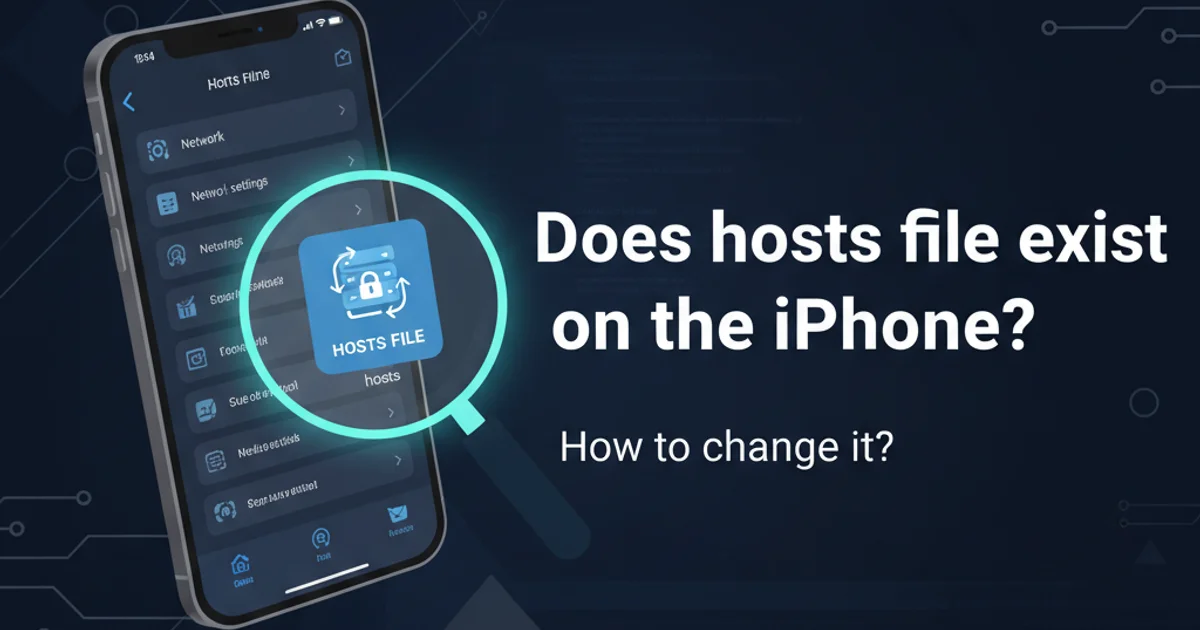Does hosts file exist on the iPhone? How to change it?
Categories:
Does the iPhone Have a Hosts File? How to Modify It?

Explore the existence and accessibility of the hosts file on iOS devices, and understand the methods (or lack thereof) for modifying DNS resolution on your iPhone.
The hosts file is a plain-text file in operating systems that maps hostnames to IP addresses. It's a fundamental part of how computers resolve domain names, often used for blocking websites, redirecting local development domains, or bypassing DNS issues. Many users, familiar with its utility on desktop operating systems like Windows, macOS, or Linux, often wonder if their iPhone possesses a similar mechanism and, if so, how they can modify it.
The Hosts File on iOS: A Different Approach
Unlike traditional desktop operating systems, iOS (the operating system for iPhones and iPads) does not expose a user-accessible or modifiable hosts file in the same way. Apple's security architecture is designed to be highly sandboxed, limiting direct user or application access to core system files to maintain stability, security, and a consistent user experience. This means you cannot simply navigate to a specific directory and edit a hosts file using a text editor on a non-jailbroken iPhone.
flowchart TD
A[User Wants to Modify Hosts File on iPhone]
B{Is iPhone Jailbroken?}
A --> B
B -- No --> C[No Direct Access to /etc/hosts]
C --> D[Alternative: DNS Configuration or VPN]
B -- Yes --> E[Access to /etc/hosts via SSH/File Manager]
E --> F[Modify hosts file (Requires caution)]
D --> G[Limited Scope: Network-specific or App-specific]
F --> H[System-wide changes (Risk of instability)]Decision flow for modifying hosts file on iPhone
Why the Restriction? Security and Simplicity
Apple's design philosophy prioritizes security and ease of use. Allowing direct modification of system files like hosts could introduce vulnerabilities, enable malicious software to redirect traffic, or lead to system instability if not handled correctly. For the vast majority of iPhone users, this level of control is unnecessary and potentially detrimental. Instead, iOS provides more controlled mechanisms for network configuration.
Alternatives for DNS Resolution on iPhone
While you can't directly edit a hosts file, there are several methods to influence DNS resolution on your iPhone, each with its own scope and limitations:
1. 1. Configure Custom DNS Servers (Wi-Fi Specific)
You can change the DNS servers used by your iPhone for specific Wi-Fi networks. This is useful for using public DNS services like Google DNS or Cloudflare DNS, or for connecting to a corporate network that requires specific DNS. This change is applied per Wi-Fi network and does not affect cellular data or other Wi-Fi networks.
2. 2. Use a VPN (Virtual Private Network)
A VPN can route all your network traffic, including DNS requests, through its own servers. Many VPN services offer custom DNS features or simply use their own DNS, effectively bypassing your ISP's or local network's DNS settings. This provides a system-wide change to DNS resolution.
3. 3. DNS Proxy Apps
Some apps available on the App Store act as local DNS proxies. These apps install a local VPN profile that intercepts DNS requests and resolves them using custom rules or servers defined within the app. This can achieve similar results to a hosts file for specific domains, but it's app-dependent and might not cover all scenarios.
4. 4. Jailbreaking (Advanced and Not Recommended)
Jailbreaking your iPhone removes Apple's software restrictions, granting root access to the file system. On a jailbroken device, you can access and modify the /etc/hosts file using SSH or a file manager. However, jailbreaking voids your warranty, can introduce security vulnerabilities, and may lead to system instability or bricking your device. It is generally not recommended for the average user.
Each of these methods offers a different level of control and impact on your iPhone's network behavior. For most users, configuring custom DNS for Wi-Fi or using a reputable VPN service will address common needs without compromising device security or stability.